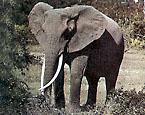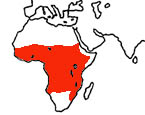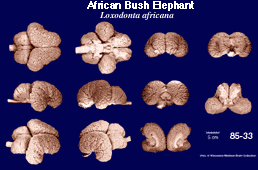|
African
Bush Elephant
(Loxodonta africana) #85-33 |
||||
|
|
Physical
characteristics and distribution
|
|
African Elephants are the largest living terrestrial mammals. Their big ears serve to dissipate body heat and to brush away insects from their eyes. The upper incisors form tusks and the trunk, or proboscis, has two fingerlike processes at the tip. The trunk is extremely sensitive to touch and can be used to feel and manipulate and grasp objects and materials with great accuracy, precision and strength. The trunk and the nostrils of elephants is used for breathing, eating, and drinking. They water into the trunk, and then squirts it into their mouth. With the tip of their trunk, elephants separates bits of grass, leaves, and fruit and then places the food into their mouths. Elephants may weigh from 2,800 kg to 6,300 kg; males weigh more than females and African Forest Elephants are bigger than Bush Elephants. African Bush Elephants are active both at night and during the day. They sleep at anytime of the day by leaning against a tree, lying down, or standing. They enjoy bathing, or dipping their nostrils in water holes. They aspirate water into their trunks and then blow it into their mouths or onto their body. They feed on grass, tree foliage, bark, twigs, herbs, shrubs, roots, and fruit. Altogether, elephants consume more than 225 kilograms (500 pounds) of vegetation a day, spending hours eating it. Due to their large size, African Bush Elephants must drink water daily. Breeding
occurs throughout the year but a female will only give birth
once every four years. A large family group is protective
of infants and the young. African
Bush Elephants are distributed throughout Sub-Saharan, except
the C and W coast of Africa, including 30 countries from Senegal
in the west to Somalia in the east. They live in many kinds
of habitats; deep forest, open savannas, wet marches, thornbush,
and semidesert scrub. |
|
Description
of the brain
|
|
Animal
source and preparation
|
|
We have two specimens of the African Bush Elephant. One of these was fixed by perfusion through the carotid arteries by Dr. Roger Reep of the University of Florida. The other specimen was exposed in the basocranial skull and immersed in a solution of formol-saline. The better perfused specimen is shown in the photographs, and was embedded in celloidin. It is awaiting sectioning and staining in the custody of Dr. E. G. Jones at the University of California, Davis. Both specimens were flown to an animal sanctuary in Florida and were obtained for our brain collection when they were only a few years old. |
Other Related Resources (websites and publications)
List of Specimens | Explore Collections | Brain Sections | Brain Evolution | Brain Development | Brain Circuitry | Brain Functions | Location and Use | Related Web Sites | Contact Us | Search MSU Database | Personnel | Home



